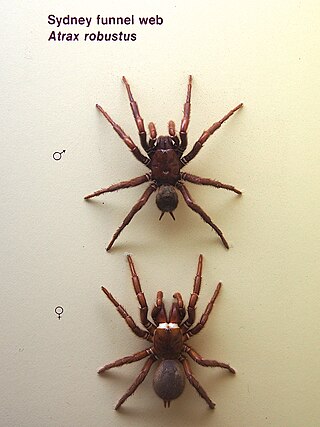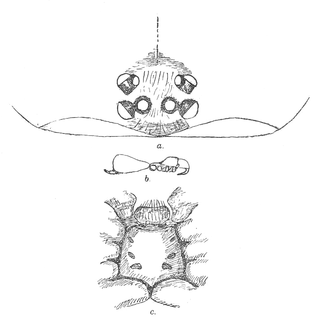
The Sydney funnel-web spider is a species of venomous mygalomorph spider native to eastern Australia, usually found within a 100 km (62 mi) radius of Sydney. It is a member of a group of spiders known as Australian funnel-web spiders. Its bite is capable of causing serious illness or death in humans if left untreated.

The giant burrowing cockroach is also known as the rhinoceros cockroach, and Queensland giant cockroach. These cockroaches are native to Australia and mostly found in tropical and subtropical parts of Queensland. They are the world's heaviest species of cockroach and can weigh up to 30-35 grams and measure up to 7.5-8 cm (3.1 in) in length. It is a member of the family Blaberidae, which contains hundreds of species. It is part of the blaberid subfamily Geoscapheinae. It is prominent in the wild and can also be sold and kept as a pet.

Missulena is a genus of mygalomorph spiders in the family Actinopodidae. It was first described by Charles Walckenaer in 1805, and is a senior synonym of Eriodon. M. tussulena is found in Chile, but the rest are indigenous to Australia. They are sometimes referred to as "mouse spiders" from the now-disproven belief that they dig deep burrows similar to those of mice. Scotophaeus blackwalli is also called a "mouse spider", but it is smaller and not closely related.

Selenocosmia crassipes, synonym Phlogius crassipes, also known as the "Queensland whistling tarantula", "barking spider" or "bird-eating tarantula" is a species of tarantula native to the east coast of Queensland, Australia. The name "whistling tarantula" comes from its ability to produce a hissing noise when provoked, a trait it shares with other Australian theraphosids. This hissing is produced by the spider stridulating a patch of setae associated with its chelicerae. It has also been called the "eastern tarantula". The species name crassipes is Latin for "fat leg" referring to the relatively fat front legs.

Idiosoma is a genus of Australian armoured trapdoor spiders that was first described by Anton Ausserer in 1871. Originally placed with the Ctenizidae, it was moved to the armoured trapdoor spiders in 1985. The name is derived from the Greek ἴδιος, meaning "individual, unique", and σῶμα, meaning "body", referring to the distinctive structure of the abdomen.

Stanwellia grisea, also known as the Melbourne trapdoor spider, is a species of mygalomorph spider in the Pycnothelidae family. It is endemic to Australia. It was described in 1901 by British arachnologist Henry Roughton Hogg.

The Brigalow Belt is a wide band of acacia-wooded grassland that runs between tropical rainforest of the coast and the semi-arid interior of Queensland and northern New South Wales, Australia. The Interim Biogeographic Regionalisation for Australia (IBRA) divides the Brigalow Belt into two IBRA regions, or bioregions, Brigalow Belt North (BBN) and Brigalow Belt South (BBS). The North and South Brigalow Belt are two of the 85 bioregions across Australia and the 15 bioregions in Queensland. Together they form most of the Brigalow tropical savanna ecoregion.
Euoplos is a genus of armoured trapdoor spiders that is endemic to Australia. It was first described by William Joseph Rainbow in 1914.

Aptostichus barackobamai is a large species of trapdoor spider in the family Euctenizidae named after the 44th President of the United States, Barack Obama. The species was first reported by Jason Bond of Auburn University in December 2012 as one of 33 new species of the genus Aptostichus. The species is endemic throughout northern California, forming burrows out of silk, dirt, and sand, from which it attacks prey. This spider is identified by its dark red to red-brown coloration with a stripped or chevron patterned abdomen. Breeding occurs during the winter and females tend to be larger than their male counterparts. A. barackobamai is part of the larger Aptostichus icenoglei species complex, and is a close relative to Aptostichus icenoglei and Aptostichus isabella.

Cantuaria dendyi is a species of trapdoor spider in the family Idiopidae. It can be found in the South Island of New Zealand and is limited to the Christchurch and Banks Peninsula area.
Euoplos spinnipes is a species of armoured trapdoor spider in the family Idiopidae. It is found in Queensland, Australia.
Euoplos crenatus is a species of mygalomorph spider in the Idiopidae family. It is endemic to Australia. It was described in 2019 by Australian arachnologists Jeremy Wilson, Michael Rix and Robert Raven.
Euoplos goomboorian is a species of mygalomorph spider in the Idiopidae family. It is endemic to Australia. It was described in 2019 by Australian arachnologists Jeremy Wilson, Michael Rix and Robert Raven. The specific epithet refers to the type locality.
Euoplos thynnearum is a species of mygalomorph spider in the Idiopidae family. It is endemic to Australia. It was described in 2019 by Australian arachnologists Jeremy Wilson, Michael Rix and Robert Raven.
Euoplos turrificus is a species of mygalomorph spider in the Idiopidae family. It is endemic to Australia. It was described in 2019 by Australian arachnologists Jeremy Wilson, Michael Rix and Robert Raven.
Euoplos grandis, also known as the Toowoomba trapdoor spider, is a species of mygalomorph spider in the Idiopidae family. It is endemic to Australia. It was described in 2019 by Australian arachnologists Jeremy Wilson, and Michael Rix.
Euoplos regalis, also known as the regal trapdoor spider or the regal golden trapdoor spider, is a species of mygalomorph spider in the Idiopidae family. It is endemic to Australia. It was described in 2021 by Australian arachnologists Jeremy Wilson and Michael Rix.
Euoplos ornatus is a species of mygalomorph spider in the Idiopidae family. It is endemic to Australia. It was described in 1918 by Australian arachnologists William Joseph Rainbow and Robert Henry Pulleine.
Euoplos similaris, also known as the banded golden trapdoor spider, is a species of mygalomorph spider in the Idiopidae family. It is endemic to Australia. It was described in 1918 by Australian arachnologists William Joseph Rainbow and Robert Henry Pulleine.
Euoplos variabilis, also known as the Mount Tamborine trapdoor spider, is a species of mygalomorph spider in the Idiopidae family. It is endemic to Australia. It was described in 1918 by Australian arachnologists William Joseph Rainbow and Robert Henry Pulleine.








